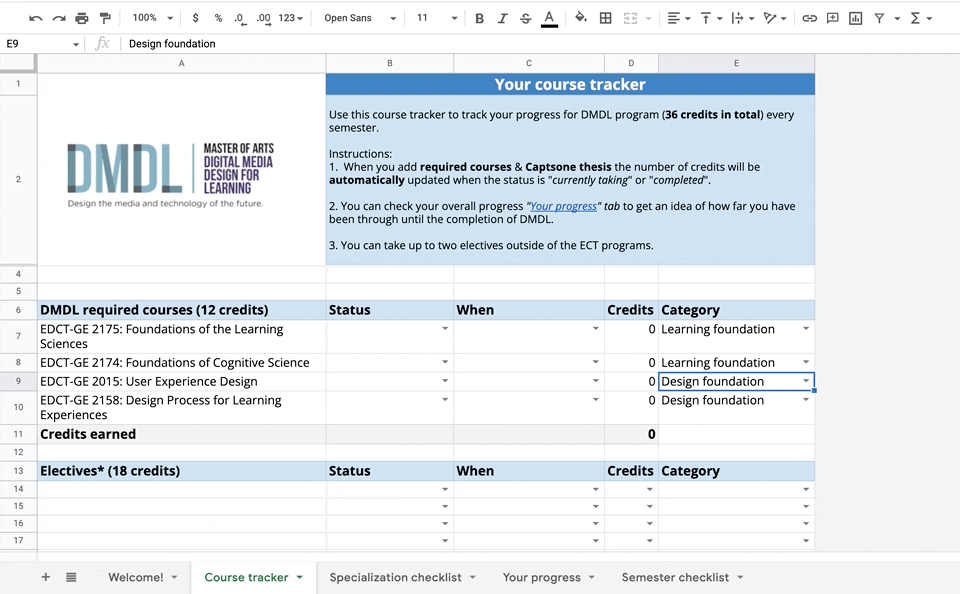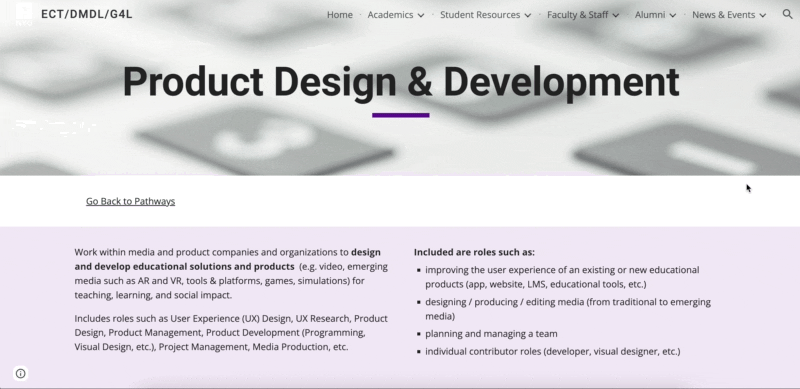
Plan your electives wisely!
A learning experience design project that aims to build tools to provide NYU’s ECT students with course planning strategies in a self-paced and self-supervised way.
This project is sponsored by ECT program director Maaike Bouwmeester

Project Introduction
This project aims to perform a research study on current ECT (Education, Communication and Technology program at NYU Steinhardt School of Education) master students to learn about their process and thoughts on their elective courses selections and plannings, in order to come up with a solution to better assist the students in making more thoughtful and mindful course planning without being frustrated and overwhelmed.How might we help the students to plan out their courses, electives in particular, best match and align with their academic and personal interests in a seamless and inspirational way?
Timeline: Jan. 2022 - May 2022 (further work being carried by continuing students due to graduation)
Teammates: Viktoriia Zykina and Chitvan Bindal
My role: Experience designer and UX researcher
Problem statement
Current ECT (Education, Communication and Technology program at NYU Stein) master's students have been reporting having a challenging time planning, choosing and registering for electives in and out of ECT program, especially for students in their second semester and beyond. There are various reasons and causes that students are facing situations like this, and some of them are:
Knowledge gap: not knowing what are available out there and what would benefit them the most
Communication gap: no point of person to turn to in asking for useful advice, especially during the pandemic
Environmental gap: unable to register for electives due to logistical reasons
Self-awareness: not knowing their goals or lack of time to plan
...
How Might We help ECT students (especially those in their second semester and beyond) to better plan out their course schedules for the semester without being frustrated and anxious [So that] they can benefit the most out the courses for their personal and career goals?
Target audience
Our target audience for this project are current ECT (both DMDL and G4L) students, and specifically, ECT students who plan to register for elective courses for the next semester or any upcoming semester. Those students can include:
Students have experience in US higher ed experiences or no experience
Full-time students vs. Part-time students
Students who are new to exploring possibilities in edTech or come with clear career goals in mind
First semester or second and beyond students
Learning goals
The goals of this project is trying to provide students seamless and intuitive elective course planning and registration experience by redesigning, integrating and re-implementing the necessary information that students need to know and want to know on ECT’s available tools at the moment. By implementing this new experience, students will be able to:
Establish [a] reliable and responsive reference points to go when they need to plan out the electives when the registration period comes
Be aware of the procedures of registering for non-ECT electives and be able to successfully enroll in the electives that students would like to take within the timeframe successfully.
Plan out their electives wisely and with less effort based on their own specific criteria (career goals, skillsets, exploration)
In the long run, students would be able to:
Build a network or community of peers, cohorts, and alumni who share similar career goals that can help each other out in a mutual way in terms of course selection, schedule planning, and even career paths
Build up a comprehensive understanding and application of a series of skillsets students need in terms of career goals and enhance them by taking electives in and out of ECT
Improve the elective selection process with more information such as tips and tricks and electives options to help the fellow/incoming ECT students to better plan out their schedule
Painpoints
In order to better understand the problems on course selections overall, we talked to 8 current ECT students of different academic years and working experiences to understand their process of course selection, from research, discovery, and registration to enrollment, as well as students’ usage of the existing ECT and NYU tools along the process.
After talking with current ECT students (including ourselves being both the designers and potential users), we found that “ECT students need more accessible guidance and references in choosing electives (in and out of the program) to take to best align their career or personal goals”. However, there are a series of gaps that are making the process a bit challenging. Due to the time constraints we had for this project (as a semester-long project), we decide to work on minimizing the knowledge gap in the following aspects:
Not always knowing which courses are available or in other programs
Not knowing how to register for them (permissions, pre-requisites, enrollment process)
Not knowing what options there are in ECT or in other programs that best align with their career goal or the career pathway
Do not know how to best utilize ECT available resources in planning out courses
Do not know where they are in the program in order to plan out their courses rationally and strategically
Design solution
As a team, we were envisioning a tool that can collect useful data information from the current ECT students based on the courses they chose to register, and categorize them by programs, student status (international, native, etc), course experiences, and registration notes.
Comparative analysis: Atlas
Atlas is an academic planning platform that displays data about the U-M curriculum to guide U-M students, instructors, and staff in decision-making. What makes it unique are:
Using data to generate references for students to plan out the course, featuring in professor ratings, grades, and student information(degree, affiliation, year of the semester, common course pathways, etc)
Data about the student body who took the course in terms of their personal academic information can be a great reference point for prospective students to make a decision of taking a certain course or not
Altas also works as a course planner for the students to see where they are in the completion to their programs
Atlas from University of Michigan, Center for Academic Innovation
Atlas from University of Michigan, Center for Academic Innovation
Challenges we face:
However, as a program, we do have a limited budget and talents that we are not able to develop such a proficient and well-design application; data collection might also be time-consuming involving department and university-level approval.
Decision: redesigning the existing tools with new approaches and new information architecture
The ECT program, unlike many other programs at NYU, we do value students’ voices and have already designed a bunch of tools for students in terms of course planning and course selections at ease. However, those design solutions are usually carried out without sufficient user research and testing that sometimes students either have no idea of these tools being existed, or just simply do not use them because students do not find them as helpful as they imagined.
As a team, we decide to redesign the existing tools that ECT has already introduced to the students, particularly :
Course database on Airtable
Course tracker on Google Spreadsheet
Final deliverables
Solution 1: redesigning the “course tracker”
ECT students are provided with this course tracker by the program when they first join the program. This course tracker was designed to help students to keep on track of their required courses towards completion and checkboxes to pay attention upon registration. According to ECT program director (also the stakeholder and sponsoring faculty for this project) Maaike Bouwmeester that this course planner was designed in a rush over one summer semester that there is room to improve in terms of user experience and visual layout. As a team, we learned that students are aware of this course tracker, however, not everyone finds it helpful in helping them planing out the course. The major problems are:
Visually hard to use and too much filling out
Doesn’t show a systemic summary of where students are in the program
Have to manually update everything every semester
The original course tracker designed by ECT program (sample information filled out is from me personally)
Feature 1: Redesign of the user interface
By breaking the information on one tab into several tabs on the same spreadsheet, I made it easier for the students to navigate through different pieces of information about their courses and processes in the program
Other than having all the resources as “more information of xxx”, I have all the resources in descriptive text with hyperlinks to avoid confusion and offload the cognitive load
I color-coded the entire spreadsheet based on the brand color of ECT program with clean and accessible visual aesthetics and design
Incorporated a welcoming instructional message to onboard students
Feature 2: Automation
The new course tracker is able to calculate the credits the students have earned so far according to the change of status of each course.
The required courses are pre-filled in the course tracker, and students only need to fill out the elective courses they are taking to see where they are in terms of completion.
Tab “Your progress” shows the students where they are to completion in a quick progress bar based on category.
All the automations are achieved by Google Sheets formulas.
Solution 2: ECT course database via Airtable
ECT faculty members have built a database with all the ECT courses and out-of-ECT courses which are aligned with program specializations on Airtable a couple of years ago, but not until recent semesters, ECT students start to actively use it to plan out their courses over the semester. Based on our user research, a great number of students find the information on the database was very useful, however, the overall layout and design is not intuitive and easy to navigate, and the information there is not up-to-date often. As a team, we deployed some redesign decisions in the information architecture and visual layout of the database.
The original version of Airtable database before re-design
Feature 1: multiple pre-sorted views
We created multiple views based on the factors students emphasized the most during course registration process, which include:
Availability
Schools of programs
Topics of the course
Alignment with ECT specializations
Grand view of all the courses on the database
Feature 2: new information architecture
In addition to the existing information about each course, we have also added additional information that students think might be useful for their course planning. This part of re-design includes:
Adding information about the faculty information, schedules, course description and alignment of specializations
Re-ordered the information based on its relevance to the views and students’ needs based on user research
Use color coding to highlight information and offload some cognitive loads for students when scanning through a large amount of text
Feature 3: bridging the communication gap
This is a new feature designed by the team in order to bridge the communication gap that students find it difficult to know what other peers in the community have taken before. We had this idea from Atlas on proving references and recommendations of what to take based on student data, however, due to technical difficulties, we have to use the “traditional” survey way to collect data and information, and make them available for the ECT community safely and anonymously.
Students will fill out a short survey asking about their experiences of an elective course they want to share, from registering to actually take it
The information will be automatically filled out in the Airtable tab “recommending an elective”
Fellow students can read that information on a gallery card view; faculty members will be periodically going through the course submissions and add them to the corresponding tabs (ECT or non-ECT).
Feedback
We launched a pilot group in testing out the two redesigns we worked on with some current ECT students to gather information for the iterative design process. We imposed some revisions to the final design decisions we have (as above), and also include a walk-through instruction guide for the students to best use the Airtable, and for the administrators to update the database at ease.
This is a work-in-progress project. Researching and registering for an elective course isn’t easy with a lot of logistical limitations we have within the university. The goal of our project is to assist the students with some reference points of what are possible out there in other colleges at NYU. We try to build a learning community that encourages everyone to learn and help each other out.
Reflections
As a learning experience designer and a member of ECT community, I have also worked on several ECT projects as a volunteer in order to help the program generate more support and values for students in different ways. This project is also connected to a summer project I worked on to onboard new students to ECT program.
Me and several other ECT students worked on compiling a fun faculty introduction video for the new students to get to know more about the faculty members from a personal and professional aspects by having them answering a series of questions. It is one of the solutions to create the bonds of students and ECT community under pandemic and remote learning situation.
Me (as visual designer) and several other ECT students worked on redesigning “Career pathway” page ECT student website by gathering information from research and alumni insights. I was responsible of designing the poster of “qualifications and skills”
For the multiple design projects I have done for ECT community, I was one of the recipients of “Outstanding Scholarship Award” by the department to recognize my “service and exemplary academic achievement, leadership, and service” to ECT. I am always dedicated in building a supportive learning community by creating bonds among the members, and I am excited for what I have contributed to the ECT community overall.


















